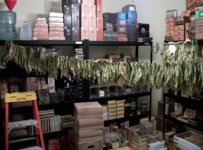You are using an out of date browser. It may not display this or other websites correctly.
You should upgrade or use an alternative browser.
You should upgrade or use an alternative browser.
Phoenix, AZ Grow Blog - 1st Try
- Thread starter Old Putt Cigars
- Start date
- Status
- Not open for further replies.
If you have garage space, buy a large, plastic dropcloth, and build a tent for color-curing. Include a fan and a couple of water containers that have a towel dipped into the water at one end.
Bob
Bob
I sun cured my flue cure varieties and Orientals last year. I'll do it again this year. The flue cure varieties that were sun cured seemed a little sweeter than the ones that were air cured. I let them yellow in the shop before moving them into the sun.
Once your leaves have yellowed in your humidor you can move them to an area with lower humidity and/or higher heat since the risk of drying green is gone. (house, attic, crawl space, shop, shed, etc.)
Once your leaves have yellowed in your humidor you can move them to an area with lower humidity and/or higher heat since the risk of drying green is gone. (house, attic, crawl space, shop, shed, etc.)
Old Putt Cigars
Well-Known Member
Both good ideas - I'll try some of these. Thanks.
Old Putt Cigars
Well-Known Member
I have had one (1) huge Horn Worm & three (3) Hummingbird Sized Grasshoppers. Both were found by noticing the black droppings on the bright leaves & stalks. Both Un-Holy scourges can devour 2-3 leaves per day - per head. I have not used insecticide yet, just catching & killing as I find them.
My Turkish needs suckering almost every day – turns out to be a good thing because that gives me a reason to turn & inspect all of the plants leaves. That’s when I find the droppings.
My Turkish needs suckering almost every day – turns out to be a good thing because that gives me a reason to turn & inspect all of the plants leaves. That’s when I find the droppings.
Old Putt Cigars
Well-Known Member
The growing season is so long here that I have decided to leave one main sucker per plant as close to the bottom of the stalk as I can manage. I’ll try to produce a new plant from them after taking the old (first grow) stalk. If they’ll produce a new plant without having to establish a new root system in this heat, that’ll be dandy!
Old Putt Cigars
Well-Known Member
FYI: I’m growing six (6) varieties. Their traits in the Phoenix Desert as best I can tell, are as follows:
African Red
Height: 8’ Plus
Suckers: Few
Heat Tolerance: Droop at 105 f
Hickory Prior
Height: 6-7’
Suckers: Few
Heat Tolerance: Droop at 107 f
Southern Beauty
Height: 6-7’
Suckers: Few
Heat Tolerance: Droop at 105 f
Black Sea Samson
Height: 6’
Suckers: Many. The suckers, suckers sucker
Heat Tolerance: No Droop Yet – 114 f
Orinoco
Height: 5-6’
Suckers: Few
Heat Tolerance: Droop at 105 f
Hopi (Rustica)
Height: 2-3’
Suckers: All Suckers & Blooms
Heat Tolerance: No Droop Yet – 114 f
African Red
Height: 8’ Plus
Suckers: Few
Heat Tolerance: Droop at 105 f
Hickory Prior
Height: 6-7’
Suckers: Few
Heat Tolerance: Droop at 107 f
Southern Beauty
Height: 6-7’
Suckers: Few
Heat Tolerance: Droop at 105 f
Black Sea Samson
Height: 6’
Suckers: Many. The suckers, suckers sucker
Heat Tolerance: No Droop Yet – 114 f
Orinoco
Height: 5-6’
Suckers: Few
Heat Tolerance: Droop at 105 f
Hopi (Rustica)
Height: 2-3’
Suckers: All Suckers & Blooms
Heat Tolerance: No Droop Yet – 114 f
Old Putt Cigars
Well-Known Member
Weather is now 110 f plus daily. Have lost a dozen or more leaves to wilt by watering one time daily in the evening!
Must now water Two (2) times per day all the way to the pails’ brim.
Once in the evening when the sun is off & once at 1:00 in the afternoon to survive the Heat of the Day (3:00 – 4:00). Must also be careful not to wet the plant leaves when the sun is out. Not a problem since a couple of priming’s have been done.
Must now water Two (2) times per day all the way to the pails’ brim.
Once in the evening when the sun is off & once at 1:00 in the afternoon to survive the Heat of the Day (3:00 – 4:00). Must also be careful not to wet the plant leaves when the sun is out. Not a problem since a couple of priming’s have been done.
Old Putt Cigars
Well-Known Member
Those are some nice looking plants. Can't say I've ever seen tobacco growing alongside cacti before. If you put down a thick layer of mulch in those buckets it might help retain some moisture.
AmaxB
Well-Known Member
Just looked through from start to date - Nice Grow!
Brown Thumb
Well-Known Member
That is a nice Bucket Grow. Whoever says it can't be done need a slap in the face.
Brown thumbs up to you Sir,
Brown thumbs up to you Sir,
I have had one (1) huge Horn Worm & three (3) Hummingbird Sized Grasshoppers. Both were found by noticing the black droppings on the bright leaves & stalks. Both Un-Holy scourges can devour 2-3 leaves per day - per head. I have not used insecticide yet, just catching & killing as I find them.
Both BT (Bacillus Thuringiensis) and Spinosad are not poisons. They are biologic controls for the hornworms, budworms and cutworms. They are safe for humans and beneficial insects such as honey bees, lady bugs, etc. They target only certain species and even those species must eat some leaf for the control to be effective. Contact with the pest will not do anything, the pest must eat your leaf.
By biologic control, I just mean that it does not work like a poison. There is something in it that I believe disrupts the immune system of the worms. They eat your leaf and either get a tummy ache and die, or their immunity is weakened and they die from the flu or something. It's been a while since I read the literature, but was sold on it at the time that I did read.
Spinosad lasts twice as long as BT between applications, cutting down on work and materials. This is substantiated by the literature provided by both products and my own experience. Spinosad will withstand more rain showers. (not something you'll be overly concerned with) I used BT last year and switched to Spinosad this year due to some advice by Jitterbugdude. (JBD loves organic growing)
http://en.wikipedia.org/wiki/Bacillus_thuringiensis
http://en.wikipedia.org/wiki/Spinosad
Old Putt Cigars
Well-Known Member
Both BT (Bacillus Thuringiensis) and Spinosad are not poisons. They are biologic controls for the hornworms, budworms and cutworms. They are safe for humans and beneficial insects such as honey bees, lady bugs, etc. They target only certain species and even those species must eat some leaf for the control to be effective. Contact with the pest will not do anything, the pest must eat your leaf.
By biologic control, I just mean that it does not work like a poison. There is something in it that I believe disrupts the immune system of the worms. They eat your leaf and either get a tummy ache and die, or their immunity is weakened and they die from the flu or something. It's been a while since I read the literature, but was sold on it at the time that I did read.
Spinosad lasts twice as long as BT between applications, cutting down on work and materials. This is substantiated by the literature provided by both products and my own experience. Spinosad will withstand more rain showers. (not something you'll be overly concerned with) I used BT last year and switched to Spinosad this year due to some advice by Jitterbugdude. (JBD loves organic growing)
http://en.wikipedia.org/wiki/Bacillus_thuringiensis
http://en.wikipedia.org/wiki/Spinosad
Looks like you’ve done your homework again Knuck! Good advice as always & thanks for the helpful info.
Don’t get me wrong, I am not an organic guy by a long shot. If there was a Low Level Nuke I could use to eradicate the vermin and leave most of the neighborhood (and all of my tobacco) standing, Yellowcake would be in an I-Net shopping cart somewhere. The only research I would require is “Would I Glow Bright Enough to Keep Me Awake at Night” post application & PHI (Pre Harvest Interval)!
It’s simply a matter of economics. The application of “anything” is going to set me back $20.00 or more in order to save a few pennies’ worth of leaves (have lost 10-12 leaves so far). If I start losing the equivalent of ounces of dried leaf, I’ll reset my thinking and take my medicine.
Old Putt Cigars
Well-Known Member
Those are some nice looking plants. Can't say I've ever seen tobacco growing alongside cacti before. If you put down a thick layer of mulch in those buckets it might help retain some moisture.
That’s a good idea. Pea Gravel would be as well (per Mad Oshea). But I intend to combine, re-fertilize & recycle the soil at some point. Do you know how that would affect that process? Seems to me, “Small Shredded” mulch might be the most effective when mixed? I wonder how many times you could float it to the top of the pail during watering and have it re-settle before mixing/migrating into the soil and losing its effectiveness as a sum block? Any experience?
leverhead
Well-Known Member
You could try making a screen with hardware cloth and 2X4's. Screen the gravel before the first use and only use what stays on the screen. After that, the soil should pass through and the gravel and roots you missed should stay on top of the screen.
Old Putt Cigars
Well-Known Member
Grasshopper Update: Have found four tiny, bright "tobacco green" baby grasshoppers merrily making pinholes in the my leaves. Of the three huge grasshoppers spotted & killed, apparently one deposited eggs in one of the pails. According to the info. I've found, they lay several pods of 60-80 eggs each, under the soil. Just lucky there haven't been 204 rather than four! My guess is that by having to flood water the pails twice a day, I've unknowingly drowned most of them before they were unleashed on the plants. I think the next one I kill; I'll impale on an 8’ medieval pike and stake him at the edge of the patch as a warning to his tribe!
leverhead
Well-Known Member
...I think the next one I kill; I'll impale on an 8’ medieval pike and stake him at the edge of the patch as a warning to his tribe!
As long as you don't fear a retribution raid for the poor treatment of their dead.
That only works if they are self-aware. If they are self-aware, then leverhead has a good point.I think the next one I kill; I'll impale on an 8’ medieval pike and stake him at the edge of the patch as a warning to his tribe!
Bob
Mad Oshea
Taking a break
Use the garlic, dish soap and oil to stop them. I had Dopler swarms here and got the job done. Mad-
- Status
- Not open for further replies.







